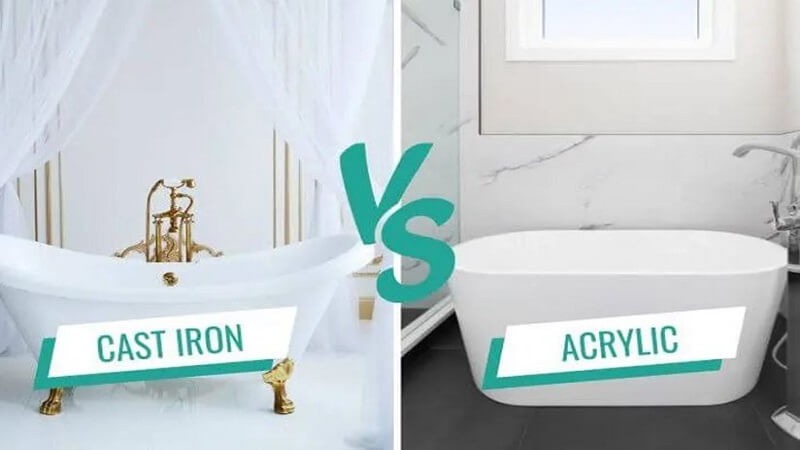When planning a bathroom renovation or designing a new one from scratch, one of the most important decisions you’ll face is selecting the right bathtub. Among the many options available, acrylic and cast iron bathtubs are two of the most popular choices—each with its own set of advantages, drawbacks, and aesthetic appeal.
But how do you choose between them? This guide will walk you through the key factors to consider, from budget and bathroom space to installation needs, aesthetics, durability, and maintenance. By the end, you’ll have a clear understanding of which bathtub type best suits your lifestyle, design preferences, and renovation goals.
Basic Introduction
Acrylic bathtubs are known for being affordable and cost-effective. They are made from thermoplastic sheets that are vacuum-formed into a variety of shapes. Because the raw materials and manufacturing processes are relatively inexpensive, these tubs tend to cost much less upfront than cast iron alternatives.
On the other hand, cast iron bathtubs are a premium option. They are made by pouring molten iron into molds, then coating the tub in a thick enamel finish. This process, along with the durability of the materials, makes them more expensive. However, many homeowners see the investment as worthwhile due to the lifespan and luxury feel.
Long-Term Value and Maintenance Costs
While acrylic tubs are cheaper to purchase, they may require more frequent maintenance over time. Acrylic is a softer material that can be prone to scratches, stains, and dulling, especially with harsh chemical cleaners or abrasive sponges. Repairs are usually inexpensive, but might be needed more often.
Cast iron bathtubs, by contrast, are exceptionally durable. They resist scratches, dents, and fading better than most other materials. Their heavy enamel finish is long-lasting, and routine maintenance usually only involves mild soap and water. If damage does occur, repairs can be costly—but such issues are rare.
Weight and Floor Support
Cast iron bathtubs are extremely heavy—some weighing 300 pounds or more before water is added. This weight means:
- You may need to reinforce your bathroom floor before installation.
- The tub’s final location must be easily accessible, with a clear path through the home to avoid installation headaches.
- Upper-floor bathrooms may pose a challenge due to structural support limitations.
Acrylic bathtubs, by contrast, are lightweight and easy to carry, making them ideal for:
- Small bathrooms
- Apartments or second-floor installations
- Quick renovations without structural changes
Fitting the Bathtub Into the Design
If your bathroom has a tight footprint or awkward corners, acrylic tubs are often easier to maneuver and install. Their flexible design options and custom sizing make them versatile for modern layouts.
Cast iron tubs, while elegant, are typically less flexible in shape and size. They shine best in spacious, traditional bathrooms with enough room to highlight their presence.
DIY vs. Professional Installation
Acrylic bathtubs are designed with easy installation in mind, making them popular among DIY homeowners. In many cases, a single person can manage the installation with basic plumbing knowledge and tools.
Cast iron bathtubs, however, often require:
- Multiple installers
- Specialized moving equipment
- Floor reinforcement
- Professional plumbing assistance
So if you’re planning to install the bathtub yourself or want a hassle-free process, acrylic is the better choice. If you’re willing to hire professionals and want a permanent, high-end fixture, cast iron is a worthy investment.
Aesthetic Preferences
Your bathtub isn’t just functional—it’s a central piece in your bathroom’s aesthetic. Whether you want a modern, sleek vibe or a cozy, vintage ambiance, both materials offer unique looks.
1. Acrylic Bathtubs: Modern Versatility
Acrylic tubs are incredibly versatile in shape, color, and style. They can be molded into:
- Freestanding designs
- Corner tubs
- Whirlpool and spa-style bathtubs
- Space-saving rectangular tubs
Because they’re easy to manufacture, they are available in a wide range of colors and finishes, making it easier to match your bathroom’s theme—be it minimalist, bohemian, or ultra-modern.
2. Cast Iron Bathtubs: Classic Elegance
Cast iron tubs are often associated with timeless elegance and luxury. Their glossy enamel coating gives them a rich finish that can last decades with minimal fading.
They are typically available in:
- Traditional clawfoot styles
- Freestanding designs with vintage curves
- Deep soaking options for luxury bathrooms
Although they don’t offer the same variety as acrylic, cast iron tubs are statement pieces—perfect for anyone looking to create a luxurious, spa-like retreat.
Durability and Lifespan
When you choose a bathtub, you’re making a long-term decision. That’s why durability should be part of your consideration.
1. Acrylic Durability
Acrylic bathtubs are durable for everyday use, but over time, the surface can:
- Scratch with abrasive materials
- Stain from harsh chemicals or hair dye
- Discolor if exposed to strong UV light or very hot water
However, they are relatively easy to repair. You can buff out scratches and even repaint faded areas.
Further reading: How Long Do Acrylic Tubs Last?
2. Cast Iron Durability
Cast iron is in a league of its own. These tubs can last 50 years or more with proper care. The enamel finish is highly resistant to scratching, chipping, and rust, and holds heat very well—making for a luxurious soak every time.
If durability and longevity are top priorities for you, cast iron is unmatched.
Heat Retention and Bathing Comfort
One of the lesser-discussed but important factors is how well the bathtub retains heat—because nothing ruins a relaxing soak faster than cold water.
Cast iron bathtubs retain heat beautifully. Their thick walls absorb and hold warmth, keeping your bathwater hot longer.
Acrylic tubs lose heat more quickly, especially in larger bathrooms or colder climates.
If you love long, indulgent baths, the heat-retention ability of a cast iron tub could be a deciding factor.
Environmental Considerations
Eco-conscious consumers may also want to consider the environmental footprint of their bathtub choice.
Acrylic is made from petroleum-based plastics and isn’t biodegradable, although it does require less energy to produce and is recyclable in some areas.
Cast iron is made from natural materials and is 100% recyclable, although it requires significantly more energy and resources to manufacture.
Neither is perfect from a sustainability standpoint, but cast iron has the edge in long-term environmental value due to its longevity and recyclability.
Conclusion: Which One Should You Choose?
Ultimately, choosing between an acrylic and cast iron bathtub comes down to your priorities and preferences:
| Criteria | Acrylic Bathtub | Cast Iron Bathtub |
| Upfront Cost | Affordable | Expensive |
| Weight | Lightweight, easy to install | Very heavy, may need professional help |
| Design Variety | High (many styles and colors) | Moderate (classic, timeless styles) |
| Durability | Moderate (can scratch) | Extremely durable |
| Heat Retention | Average | Excellent |
| Maintenance | Easy but more frequent | Minimal, very long-lasting |
| Ideal Use Case | Small spaces, budget-friendly renovations | Luxury bathrooms, long-term investments |
Whether you’re updating your guest bathroom or crafting your dream master suite, selecting the right bathtub is key to your comfort, convenience, and style. Acrylic bathtubs are flexible, affordable, and stylish—ideal for modern homes and easy DIY projects. Cast iron bathtubs offer unmatched durability, classic beauty, and a spa-like experience, but require a higher budget and professional installation.
Take your time to assess your needs, and you’ll find the bathtub that not only fits your bathroom but enhances your lifestyle as well.

